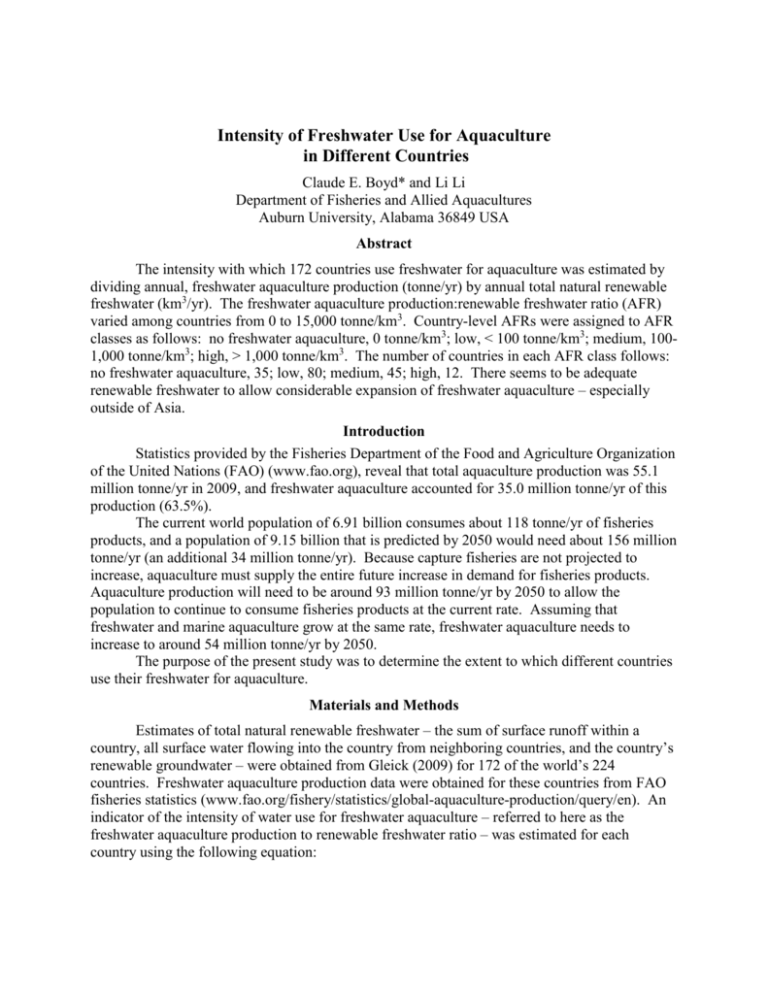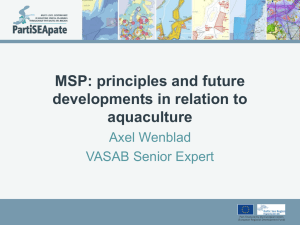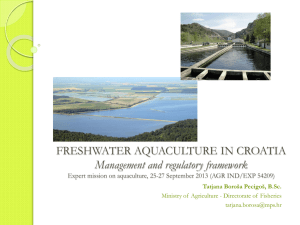intensity of freshwater use for aquaculture in different countries
advertisement

Intensity of Freshwater Use for Aquaculture in Different Countries Claude E. Boyd* and Li Li Department of Fisheries and Allied Aquacultures Auburn University, Alabama 36849 USA Abstract The intensity with which 172 countries use freshwater for aquaculture was estimated by dividing annual, freshwater aquaculture production (tonne/yr) by annual total natural renewable freshwater (km3/yr). The freshwater aquaculture production:renewable freshwater ratio (AFR) varied among countries from 0 to 15,000 tonne/km3. Country-level AFRs were assigned to AFR classes as follows: no freshwater aquaculture, 0 tonne/km3; low, < 100 tonne/km3; medium, 1001,000 tonne/km3; high, > 1,000 tonne/km3. The number of countries in each AFR class follows: no freshwater aquaculture, 35; low, 80; medium, 45; high, 12. There seems to be adequate renewable freshwater to allow considerable expansion of freshwater aquaculture – especially outside of Asia. Introduction Statistics provided by the Fisheries Department of the Food and Agriculture Organization of the United Nations (FAO) (www.fao.org), reveal that total aquaculture production was 55.1 million tonne/yr in 2009, and freshwater aquaculture accounted for 35.0 million tonne/yr of this production (63.5%). The current world population of 6.91 billion consumes about 118 tonne/yr of fisheries products, and a population of 9.15 billion that is predicted by 2050 would need about 156 million tonne/yr (an additional 34 million tonne/yr). Because capture fisheries are not projected to increase, aquaculture must supply the entire future increase in demand for fisheries products. Aquaculture production will need to be around 93 million tonne/yr by 2050 to allow the population to continue to consume fisheries products at the current rate. Assuming that freshwater and marine aquaculture grow at the same rate, freshwater aquaculture needs to increase to around 54 million tonne/yr by 2050. The purpose of the present study was to determine the extent to which different countries use their freshwater for aquaculture. Materials and Methods Estimates of total natural renewable freshwater – the sum of surface runoff within a country, all surface water flowing into the country from neighboring countries, and the country’s renewable groundwater – were obtained from Gleick (2009) for 172 of the world’s 224 countries. Freshwater aquaculture production data were obtained for these countries from FAO fisheries statistics (www.fao.org/fishery/statistics/global-aquaculture-production/query/en). An indicator of the intensity of water use for freshwater aquaculture – referred to here as the freshwater aquaculture production to renewable freshwater ratio – was estimated for each country using the following equation: AFR = AP × 100 RF where AFR = freshwater aquaculture production to renewable freshwater ratio (tonne/km3); AP = freshwater aquaculture production (tonne/yr); RF = total renewable freshwater (km3/yr). Results and Discussion Of the 172 countries for which renewable freshwater data were available, 35 had no freshwater aquaculture production, or if they did, it was not reported. For the 137 countries reporting freshwater aquaculture production, AFR ranged from < 1 tonne/km3 in several countries to 7,344 tonne/km3 in China, 11,324 tonne/m3 in Israel, and 15,000 tonne/km3 in Kuwait (Table 1). Notice that the two highest AFR values were for small, water-restricted countries. The AFR values were initially placed in five classes as follows: countries with AFR = 0 (no freshwater aquaculture); 80 countries with AFR < 100 tonne/km3; 45 countries with AFR > 100 tonne/km3 but < 800 tonne/km3, ten countries with AFR > 1,000 tonne/km3 but < 10,000 tonne/km3; two countries with AFR > 10,000 tonne/km3. However, it did not seem appropriate to assign the two countries – Israel and Kuwait – with AFR > 10,000 tonne/km3 to a separate class, because they represent an insignificant proportion of world freshwater aquaculture production (19,546 tonne/yr or 0.062%). Thus, countries were placed into four AFR classes: no reported aquaculture (AFR = 0 tonne/km3); low (AFR < 100 tonne/km3); medium (AFR = 1011,000 tonne/km3); high (AFR > 1,000 tonne/km3). Many of the countries in the no aquaculture and low AFR classes (Table 1) need additional protein that could be obtained by increasing the amount of aquaculture. There also are countries in the medium and high AFR classes that need more protein. An example of the effect of increasing freshwater aquaculture on AFR in a country with a low FCR will be provided. Guatemala has a rapidly growing population that is expected to increase from 14,362,000 in 2010 to 22,995,000 in 2050. Suppose that Guatemala increased its freshwater aquaculture production from 3,000 tonne/yr at present to 10,000 tonne in 2050. The renewable freshwater in Guatemala is estimated at 111.3 km3/yr (Gleick 2009); thus, AFR would rise from 27.0 tonne/km3 to 89.8 tonne/km3 – the country would still have a low AFR. In many Asian countries, and especially in China, increasing the amount of aquaculture will result in higher AFRs in a region where values are already much greater than in the rest of the world. Nevertheless, the data provided in Table 1 suggest that many countries could greatly increase aquaculture production without increasing AFR values to the levels found in Asia. The main negative issues related to a large amount of freshwater aquaculture production (high AFR) at the country level are competition with other water uses and water pollution resulting from aquaculture (Pillay 2004; Boyd et al. 2007; Tucker and Hargreaves 2008). However, there are no studies revealing the extent to which aquaculture interferes with other water uses or contributes to water pollution at the country level. Based on regional studies of individual aquaculture industries such as channel catfish, (Ictalurus punctatus), in the southeastern United States (Boyd et al. 2000; Tucker and Hargreaves 2008), and Pangasius catfish in Vietnam (Bosma et al. 2009), aquaculture does not appear to be of as much concern related to water use conflicts and water pollution as many other activities. Thus, there should be opportunity to greatly increase aquaculture production in many countries, and especially those outside Asia, without resulting in major water use competition or causing serious water pollution. Nevertheless, aquaculture producers should strive to increase production per unit of water use – Verdegem and Bosma (2009) suggested that productivity could be tripled without increasing current freshwater use. Moreover, governments should pay more attention to the effects of aquaculture on the environment and require producers to comply with either discharge standards, best management practices, or both. Table 1. Country-level estimates of annual total natural renewable freshwater (TNRF) (Gleick 2008), annual freshwater aquaculture production (AP), (www.FAO.org) and the freshwater aquaculture production:renewable freshwater ratio (AFR). TNRF AP AFR (tonne/ Region and country (km3/yr) (tonne/yr) km3) AFRICA Algeria 14.3 2215 154.00 Angola 184 190 1.03 Benin 25.8 180 6.98 Botswana 14.7 0 0.00 Burkina Faso 17.5 405 23.14 Burundi 3.6 200 55.56 Cameroon 285.5 340 1.19 Cape Verde 0.3 0 0.00 Central African Republic 144.4 0 0.00 Chad 43 0 0.00 Comoros 1.2 0 0.00 Congo 832 65 0.08 Congo, Democratic Republic (Zaire) 1283 2970 2.31 Cote D'Ivoire 81 1150 14.20 Djibouti 0.3 0 0.00 Egypt 86.8 98833 1138.00 Equatorial Guinea 26 0 0.00 Eritrea 6.3 0 0.00 Ethiopia 110 0 0.00 Gabon 164 124 0.76 Gambia 8 0 0.00 Ghana 53.2 5594 105.15 Guinea 226 0 0.00 Guinea-Bisseau 31 0 0.00 Kenya 30.2 4452 147.42 Lesotho 5.2 91 17.50 Liberia 232 0 0.00 Libya 0.6 10 16.67 Madagascar 337 2830 8.40 Malawi 17.3 1700 98.27 Mali Mauritania Mauritius Morocco Mozambique Namibia Niger Nigeria Reunion Rwanda Senegal Sierra Leone Somalia South Africa Sudan Swaziland Tanzania Togo Tunisia Uganda Zambia Zimbabwe 100 11.4 2.2 29 216 45.5 33.7 286.2 5 5.2 39.4 160 15.7 50 154 4.5 91 14.7 4.6 66 105.2 20 821 0 61 1185 90 15 40 143207 0 388 160 0 0 1202 2000 0 12 126 1117 52250 5640 2450 8.21 0.00 27.73 40.86 0.42 0.33 1.19 500.37 0.00 74.62 4.06 0.00 0.00 24.04 12.99 0.00 0.13 8.57 242.83 791.67 53.61 122.50 Antigua and Barbuda Bahamas Barbados Belize Canada Costa Rica Cuba Dominica Dominican Republic El Salvador Guatemala Haiti Honduras Jamaica Mexico Nicaragua Panama 0.1 nd 0.1 18.6 3300 112.4 38.1 nd 21 25.2 111.3 14 95.2 9.4 457.2 196.7 148 0 0 0 1865 9314 21768 27771 0 140 3606 3000 0 20494 5812 10618 1388 462 0.00 0.00 0.00 100.27 2.82 193.67 728.90 0.00 6.67 143.10 26.95 0.00 215.27 618.30 23.22 7.06 3.12 N & C AMERICA St. Kits and Nevis Trinidad and Tobago United States of America 0.02 3.8 3069 0 0 323905 0.00 0.00 105.54 Argentina Bolivia Brazil Chile Colombia Ecuador Guyana Paraguay Peru Suriname Uruguay Venezuela 814 622.5 8233 922 2132 432 241 336 1913 22 139 1233.2 2465 631 211766 8717 46100 22120 211 2100 14987 10 36 2625 3.03 1.01 25.72 9.45 21.62 51.20 0.88 6.25 7.83 0.45 0.26 2.13 Afghanistan Bahrain Bangladesh Bhutan Brunei Cambodia China India Indonesia Iran Iraq Israel Japan Jordan Korea DPR Korea Republic Kuwait Laos Lebanon Malaysia Maldives Mongolia 65 0.1 1210.6 95 8.5 476.1 2829.6 1907.8 2838 137.5 96.4 1.7 430 0.9 77.1 69.7 0.02 333.6 4.8 580 0.03 34.8 0 0 894205 0 4 38359 20781065 3342039 908693 150607 19246 19250 39874 330 3700 19150 300 78000 803 95843 0.00 0.00 738.65 0.00 0.47 80.57 7344.17 1751.78 320.19 1095.32 199.65 11323.53 92.73 366.67 47.99 274.75 15000.00 233.81 167.29 165.25 0.00 0.00 SOUTH AMERICA ASIA Myanmar Nepal Oman Pakistan Philippines Qatar Saudi Arabia Singapore Sri Lanka Syria Taiwan Thailand Turkey United Arab Emirates Vietnam Yemen 1045.6 210.2 1 233.8 479 0.1 2.4 0.6 50 46.1 67 409.9 234 0.2 891.2 4.1 Albania Austria Belgium Bosnia and Herzegovina Bulgaria Croatia Cyprus Czech Republic Denmark Estonia Finland France Germany Greece Hungary Iceland Ireland Italy Luxembourg Macedonia Malta Netherlands Norway 41.7 84 20.8 37.5 19.4 105.5 0.4 16 6.1 21.1 110 189 188 72 120 170 46.8 175 1.6 6.4 0.07 89.7 381.4 617859 27250 86 135000 311059 36 3753 283 5172 8595 161027 516405 66557 1771000 590.91 129.64 86.00 577.42 649.39 360.00 1563.75 471.67 103.44 186.44 2403.39 1259.83 284.43 0.00 1987.21 EUROPE 558 2087 126 7360 4562 4458 57 20395 22661 813 2159 41340 36973 3991 15687 381 850 39916 1331 8575 90 13.38 24.85 6.06 196.27 235.15 42.26 142.50 1274.69 3714.92 38.53 19.63 218.73 196.66 55.43 130.73 2.24 18.16 228.09 0.00 207.97 0.00 95.60 0.24 Poland Portugal Romania Slovakia Slovenia Spain Sweden Switzerland United Kingdom Serbia-Montenegro (Yugoslavia) Russia Armenia Azerbaijan Belarus Estonia Georgia Kazakhstan Kyrgyzstan Latvia Lithuania Moldova Tajikistan Turkmenistan Ukraine Uzbekistan 63.1 73.6 211.9 80.3 32.1 111.1 179 53.3 160.6 208.5 4498 10.5 30.3 58 12.8 63.3 109.6 46.5 49.9 24.5 11.7 99.7 60.9 139.5 72.2 36813 941 12532 1071 1041 22281 4016 1214 10563 0 115234 2001 89 4150 813 180 321 92 584 3008 4700 26 16 15027 3418 583.41 12.79 59.14 13.34 32.43 200.55 22.44 22.78 65.77 0.00 25.62 190.57 2.94 71.55 63.52 2.84 2.93 1.98 11.70 122.78 401.71 0.26 0.26 107.72 47.34 Australia Fiji New Zealand Papua New Guinea Solomon Islands 398 28.6 397 801 44.7 1127 217 0 80 2.83 7.59 0.00 0.10 0.00 OCEANIA Literature Cited Bosma, R. H., C. T. T. Hanh, and J. Potting, editors. 2009. Environmental impact assessment of the pangasius sector in the Mekong Delta. Boyd, C. E., C. Tucker, A. McNevin, K. Bostick, and J. Clay. 2007. Indicators of resource use efficiency and environmental performance in fish and crustacean culture. Reviews in Fisheries Science 15:327-360. Boyd, C. E., J. Queiroz, J. Lee, M. Rowan, G. N. Whitis, and A. Gross. 2000. Environmental assessment of channel catfish, Ictalurus punctatus, farming in Alabama. Journal of the World Aquaculture Society 31:511-544. Gleick, P. H. 2009. The world’s water 2008-2009. Island Press, Washington, D.C., USA. Pillay, T. V. R. 2004. Aquaculture and the environment, 2nd edition. Blackwell Publishing, Oxford, United Kingdom. Tucker, C. S. and J. A. Hargreaves, editors. 2008. Environmental best management practices for aquaculture. Wiley-Blackwell, Ames, Iowa, USA. Verdegem, M. C. J. and R. H. Bosma. 2009. Water withdrawal for brackish and inland aquaculture, and options to produce more fish in ponds with present water use. Water Policy 11 (Supplement 1):52-68.







